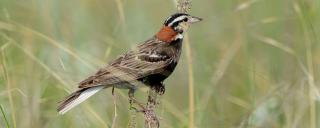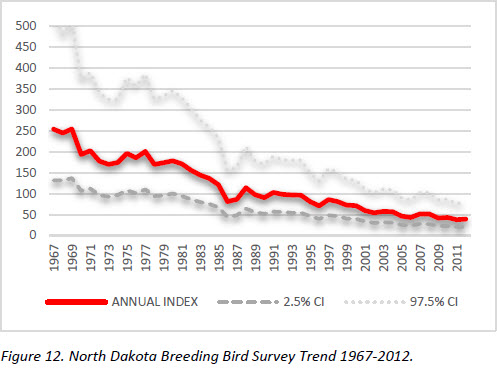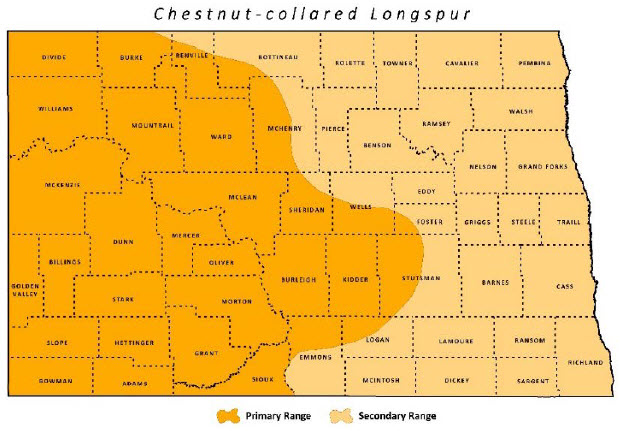

Chestnut-collared Longspur
| Scientific Name | Calcarius ornatus |
|---|---|
| General Description | L 6”, WS 10.5”, .67 oz. Males have a chestnut collar, black belly, yellow throat, black and white on top of head, and conspicuous black triangle on a white tail. Females are grayish-buff overall with some streaking. |
| Status | Occurs in North Dakota from April to mid-October. Peak breeding season early May to mid-July. |
| Abundance | Abundant to common. |
| Primary Habitat | Grazed or hayed mixed-grass prairie, shortgrass prairie. |
| Federal Status | Migratory Bird. |
| Reason for Designation | This species was very abundant in pre-settlement times. Although still rather common in North Dakota, loss of native prairie habitat continues to reduce once great numbers. It is included on the USFWS Birds of Conservation Concern list in Region 6, BCR 11 and 17 Partners in Flight (PIF) identifies the Chestnut-collared Longspur as a Regional Concern and Stewardship Species, U.S.-Canada Concern and Stewardship Species, and a Trinational Concern Species. |
Locations and Conditions of Key Habitat
Preferred Habitat
Chestnut-collared Longspurs have been described as a native prairie specialist. Level to rolling, open, arid, mixed-grass and shortgrass prairie is utilized. They avoid very shrubby areas and areas of dense litter accumulation. Native pasture with less than 20-30 cm vegetation height is preferred, but hayland is also used. Idle grassland is rarely used. Positively associated with percent clubmoss cover, percent bare ground, and plant communities dominated by native grass. Negatively associated with vegetation density, litter depth, density of low-growing shrubs, and plant communities dominated by shrubs and introduced grass such as Kentucky bluegrass. Grazed or mowed areas are typically preferred over undisturbed because of the short grass it provides, but overgrazing can be detrimental. Nest on the ground, often by a cowpie or under a clump of grass. Forage on the ground for seeds, insects and spiders.
Key Areas and Conditions for Chestnut-collared Longspur in North Dakota
No specific sites have been identified. Once common throughout state except for Red River Valley.
Problems Which May Affect this Species
Habitat
Conversion of grassland to cropland, energy development and urban expansion. Degradation of grasslands from invasive plants, woody encroachment, succession, and loss of diversity. Grazing, burning, or mowing is needed to provide short grass and remove excess litter. Deemed woodland-sensitive, occurrence declines with increasing tall shrub (>1m) cover. Increased woodland cover and brush cover negatively affects this species. Increasing loss of grassland on the wintering grounds in the Chihuahuan Desert may be contributing to the decline of Chestnut-collared Longspurs.
Other Natural or Manmade Factors
Parasitism by brown-headed cowbirds occurs but at lower rates than other grassland birds. Nest depredation is the most important factor affecting nest success, followed by weather. Pesticide acute toxicity may be a potential contributor to declines of grassland birds. Grassland birds avoid habitat within 150 meters of roads and 350 meters of oilfield infrastructure, likely due to anthropogenic disturbance of heavy traffic and/or changes in habitat near oil development.
Research and Survey Efforts
Current Research or Surveys
- Rocky Mountain Bird Observatory (ND SWG T-46-R) is estimating demographic rates of Chestnut-collared Longspur and other grassland birds in western North Dakota. A final report is anticipated in 2018.
Previous Research or Surveys
- University of Montana (ND SWG T-1-R) developed breeding bird models which link population density to local and landscape habitat features in the Prairie Pothole Region of North Dakota. hestnut-collared Longspur was one of 16 grassland bird focal species. The project was initiated in 2002, a final report was provided in 2004 (Naugle 2005), and dissertation in 2007 (Quamen 2007). Further analysis of the data was recently analyzed on 5 study species (Doherty et al. in press). Chestnut-collared Longspurs showed avoidance of cropland or selection for grassland at both the landscape and local scales, avoidance for exotic grasses, and showed negative relationship to visual obstruction.
- Little effort has been applied to research or surveys specifically for Chestnut-collared Longspurs in North Dakota. Several studies which include longspurs and other grassland associated species have taken place in North Dakota. Examples include the benefits of CRP to grassland nesting passerines and the effects of various management practices.
- Fair number of published reports and gray literature on this species throughout its range.
Additional Research or Surveys Needed
Determine the effect of Kentucky bluegrass invasion on Chestnut-collared Longspur presence/abundance.
Population and Trend Estimates

- PIF Global Population Estimate: 3,000,000
- PIF North American Population Estimate: 3,000,000
- PIF North Dakota Population Estimate: 900,000
- North Dakota BBS Trend: see figure 12
- Survey-wide BBS Trend 1966-2012: -4.23
Management Recommendations
- Protect or create large tracts of grassland, particularly native prairie.
- Prevent encroachment of woody vegetation in grasslands.
- Encourage vegetative diversity.
- Avoid managing for idle, dense vegetation.
- Practice rotational burning: intervals of 3-4 years in tallgrass prairie, 6 years in mixed-grass prairie, and 5-10 years in shortgrass prairie.
- Delay mowing until July 15.
- Use native grasses when replanting or restoring grassland.
Monitoring Plans
According to the Partners in Flight Landbird Conservation Plan, long-term population trend monitoring such as the Breeding Bird Survey is generally considered adequate, but may not account for some issues (e.g. bias). Ensuring all BBS routes are conducted annually is priority. Future monitoring proposals should follow recommendations North American Bird Conservation Initiative ‘Opportunities for Improving Avian Monitoring’.
2005-2015 Progress
The Chestnut-collared Longspur remains a Level I Species of Conservation Priority. Several State Wildlife Grant Projects (T2-11-HM, T-18-R, T-20-D, T-21-D, T-22-HM, T-23-HM, T-25-HM, T-28-L, T-37-D)) have contributed to habitat enhancement grasslands for Chestnut-collared Longspurs and other grassland dependent birds.

Note: A listing of works consulted when compiling the information on this page may be found in the 2015 State Wildlife Action Plan.
